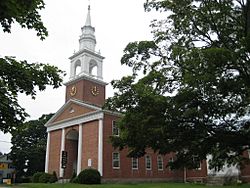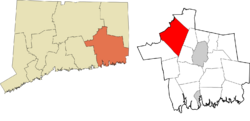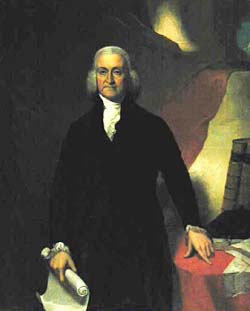Lebanon, Connecticut facts for kids
Quick facts for kids
Lebanon, Connecticut
|
||
|---|---|---|
|
Town
|
||
| Town of Lebanon | ||

The First Congregational Church on the Green, site of the first town council and featured on the town seal
|
||
|
||
 New London County and Connecticut New London County and Connecticut |
||
| Country | ||
| U.S. state | ||
| County | New London | |
| Region | Southeastern CT | |
| Incorporated | 1700 | |
| Government | ||
| • Type | Selectman-town meeting | |
| Area | ||
| • Total | 55.2 sq mi (143.0 km2) | |
| • Land | 54.1 sq mi (140.2 km2) | |
| • Water | 1.1 sq mi (2.9 km2) | |
| Elevation | 499 ft (152 m) | |
| Population
(2020)
|
||
| • Total | 7,142 | |
| • Density | 129.38/sq mi (49.944/km2) | |
| Time zone | UTC−5 (Eastern) | |
| • Summer (DST) | UTC−4 (Eastern) | |
| ZIP Code |
06249
|
|
| Area code(s) | 860/959 | |
| FIPS code | 09-42390 | |
| GNIS feature ID | 0213449 | |
Lebanon (pronounced LEB-ən-ən) is a town in New London County, Connecticut, United States. It's part of the Southeastern Connecticut Planning Region. In 2020, about 7,142 people lived here.
Lebanon is located northwest of Norwich and south of Willimantic. It's about 20 miles (32 km) north of New London and 20 miles (32 km) east of Hartford. The town is famous for its important role in the American Revolution. It was a main base for American operations. Lebanon also has a historic town green, which is one of the biggest in the country. It's still partly used for farming today!
Contents
History of Lebanon, Connecticut
From Poquechaneed to Lebanon
Lebanon was first home to the Mohegan people. They were a Native American tribe who spoke the Algonquian language. They lived in the upper Thames River Valley in eastern Connecticut. The area was called Poquechaneed and was mostly used for hunting.
The town of Lebanon started when settlers from Norwich wanted more land. In 1663, Major John Mason, who was deputy governor of the Connecticut Colony, received the first land grant here. The next year, Mason got 500 acres (2.0 km2) northwest of Norwich. This area was known as "Pomakuck" or "Pomocook" by the Mohegans. Today, it's the Goshen Hill area of Lebanon.
In 1666, Connecticut gave another 120 acres (0.49 km2) to Rev. James Fitch, a minister from Norwich. This land was next to Maj. Mason's land, which was then called Cedar Swamp. The Mohegans approved these land deals. In 1675, Mohegans gave an extra 7-mile (11 km) strip to Maj. Mason's son. He shared the land with Rev. Fitch, who was his father-in-law. This area is now known as "Fitch and Mason's Mile."
In 1692, Oweneco, son of Mohegan leader Sachem Uncas, sold 25 square miles (65 km2) of land. He sold it to four men from Norwich and Stonington. This land was called the "Five Mile Purchase." With this purchase, most of what is now Lebanon was formed.
The Connecticut Colony officially made Lebanon a town on October 10, 1700. One of Rev. Fitch's sons suggested the name "Lebanon." He thought of it because of "the height of the land, and a large cedar forest." Lebanon was the first town in the Connecticut Colony to be given a name from the Bible. It was first in New London County, then in Windham County from 1726 to 1824, and now it's back in New London County.
Lebanon: "Heartbeat of the Revolution"
During the Revolutionary War, Connecticut's war efforts were managed from the War Office on the Green. They were also directed from the nearby home of Governor Jonathan Trumbull Sr.
William Williams, who signed the Declaration of Independence, was from Lebanon. He was also Governor Trumbull's son-in-law.
Jonathan Trumbull was the only British colonial governor who supported the American rebels during the Revolution. He was one of George Washington's main supply managers. He created a Council of Safety to help the Continental Army. This council met over 1,100 times, usually at Trumbull's house on the Lebanon Green. Trumbull also managed payments for the Northern Department of the Continental Army. He was the first person to control the young nation's money during the war.
Trumbull's children also helped a lot in the war. Joseph Trumbull was a colonel in the Continental Army. Jonathan Trumbull, Jr. was George Washington's secretary. John Trumbull was a soldier and then Washington's personal helper.
In the winter and spring of 1781, a French army unit called the duc de Lauzun's Legion of Horse stayed in Lebanon. There were 220 soldiers. Even though this group later became known for being rowdy, they were mostly well-behaved in Lebanon. Only two officers were executed for trying to run away. The town's economy got a small boost from the soldiers staying there. In June, the soldiers left for White Plains, New York. Lauzun later wrote that Lebanon was like "Siberia" with "a few huts scattered among vast forests."
Because the Trumbull family and Lebanon were so important to the war, the town earned the nickname "Heartbeat of the Revolution."
Lebanon in the 1800s and 1900s
Joseph Trumbull, who was Jonathan Trumbull Sr.'s father, started livestock farming in Lebanon in 1704. By 1730, Lebanon had the biggest meat packing industry in Connecticut. Farming has been the main focus of the town ever since. After the Revolution, Lebanon became less politically important. The Trumbull family left Lebanon after Jonathan Trumbull Jr. died in 1809.
However, as towns around it became more industrial, Lebanon stayed focused on farming. This led to a big wave of immigrants in the early 1900s. After peaceful Mennonite farmers were forced out of Ukraine in the mid-1800s, German farmers settled there. Later, problems in Russia and World War I made many of these farmers move to America. An entire village called Karlswalde, near Ostrog, left. One person, Philip Krause, settled in the Village Hill area of Lebanon. The town had similar land and good soil for farming. By 1928, twelve families from Karlswalde had moved to Lebanon. Many of these families still live in Lebanon today and have greatly influenced the town's culture.
The Liberty Hill area was the main business center of Lebanon for most of the 1800s and into the 1900s. It had the town's post office and two general stores. It was Lebanon's main connection to other parts of Connecticut and New England. This area stayed important into the 1930s and 1940s. As more people got telephones, roads improved, and cars became common, people didn't need to rely on nearby stores as much. But Liberty Hill is still one of Lebanon's main neighborhoods.
At least 10% of Lebanon's residents left to fight in World War II. The Memorial Day parade is still one of the town's biggest yearly celebrations.
Lebanon Today
Today, Lebanon's economy relies a lot on farming and services. The biggest employers are farms and the school system. KofKoff Egg Farms, Connecticut's largest egg producer, has a farm in Lebanon. The Lebanon Country Fair is the earliest fair held in Connecticut each year. It is famous for its agricultural shows.
The Lebanon School District runs the town's three schools: Lyman Memorial High School, Lebanon Middle School, and Lebanon Elementary School. The Lyman Memorial Girls softball team won the State Championship in 2007. This was the only outright state championship in the school's history.
The town still centers around the Green. Many homes of important past citizens are here, including Governor Trumbull and William Beaumont. Three churches are also on the Lebanon Green: First Congregational Church of Lebanon, Lebanon Baptist Church, and Saint Francis of Assisi Roman Catholic Church. The Jonathan Trumbull Library, a popular meeting place, is also on the Green. So are the War Office, the Jonathan Trumbull Jr. house, and the Wadsworth Stable.
The Redeemer Lutheran Church is in the "Village Hill" area. The Lebanon Bible Church and Goshen Congregational Church are in the "Goshen" area. There used to be a synagogue in Goshen, but it closed. A town museum was recently built on the Green. Signs when you enter town say: "Lebanon, Connecticut Est. 1700 Preserving our History and our Agriculture."
Notable People from Lebanon
Many interesting people have lived in or come from Lebanon:
- William Beaumont (1785–1853): Known as the "Father of Gastric Physiology." His book from 1833 about digestion is still a classic medical study.
- Martha Wadsworth Brewster (1710 – about 1757): A poet and writer. She was one of the first American female writers.
- William Alfred Buckingham (1804–1875): A businessman and mayor of Norwich. He was later governor of Connecticut during the Civil War. He also served in the U.S. Senate.
- Nelson Dewey (1813–1889): The first governor of Wisconsin (1848–1852) when he was only 35.
- Ralph Gurley (1797–1872): A clergyman and chaplain for the U.S. House of Representatives. He helped the American Colonization Society, which offered free Black Americans a trip to their colony in West Africa (now Liberia).
- Prince Saunders (1775–1839): An attorney general for the Republic of Haiti.
- William Strong (1763–1840): A U.S. congressman and judge.
- Jonathan Trumbull Sr. (1710–1785): Governor of Connecticut and a strong supporter of Washington during the American Revolutionary War. He studied and died in Lebanon, where he is buried.
- Joseph Trumbull (1737–1778): A delegate to the Continental Congress in 1774. He was also a colonel in the Continental Army and a Commissary General. He was Jonathan Trumbull Sr.'s son.
- Jonathan Trumbull Jr. (1740–1809): General George Washington's secretary during the American Revolution. He later served eight terms as governor of Connecticut. He was Jonathan Trumbull Sr.'s son.
- John Trumbull (1756–1843): A famous American painter. His artwork is in the U.S. Capitol and on the back of the two-dollar bill. He was Jonathan Trumbull Sr.'s son.
- Joseph Trumbull (1782–1861): A state governor and later a Connecticut representative to the U.S. Congress. He was Jonathan Trumbull Sr.'s grandson.
- Pelatiah Webster (1726–1795): A colonial merchant and writer. He wrote essays about the money and government of the new United States.
- William Williams (1731–1811): A merchant and delegate for Connecticut to the Second Continental Congress in 1776. He signed the Declaration of Independence. He was Jonathan Trumbull Sr.'s son-in-law.
- Eleazar Wheelock (1711–1779): A minister, speaker, educator, and the person who started Dartmouth College.
Geography of Lebanon
The United States Census Bureau says that Lebanon covers a total area of 55.2 square miles (143 km2). Of this, 54.1 square miles (140 km2) is land, and 1.1 square miles (2.9 km2), or 2.05%, is water. Gates Hill is the highest point in town and in New London County, at 660 feet (200 m) high.
Main Areas in Lebanon
- Exeter
- Goshen Hill
- Lebanon Center
- Leonard Bridge
- Liberty Hill
Other smaller areas in town include Babcock Hill, Bush Hill, Chestnut Hill, Cook Hill, Coreyville, Kick Hill, Mason Hill, Scott Hill, Standish Hill, and Village Hill.
Population of Lebanon
| Historical population | |||
|---|---|---|---|
| Census | Pop. | %± | |
| 1850 | 1,901 | — | |
| 1860 | 2,174 | 14.4% | |
| 1870 | 2,211 | 1.7% | |
| 1880 | 1,845 | −16.6% | |
| 1890 | 1,670 | −9.5% | |
| 1900 | 1,521 | −8.9% | |
| 1910 | 1,528 | 0.5% | |
| 1920 | 1,343 | −12.1% | |
| 1930 | 1,436 | 6.9% | |
| 1940 | 1,467 | 2.2% | |
| 1950 | 1,654 | 12.7% | |
| 1960 | 2,434 | 47.2% | |
| 1970 | 3,804 | 56.3% | |
| 1980 | 4,762 | 25.2% | |
| 1990 | 6,041 | 26.9% | |
| 2000 | 6,907 | 14.3% | |
| 2010 | 7,308 | 5.8% | |
| 2020 | 7,142 | −2.3% | |
| Population 1990 - 2000 Population 2010 |
|||
According to the census of 2000, there were 6,907 people living in Lebanon. There were 2,446 households, and 1,934 families. The population density was about 127.6 people per square mile (49.3/km2).
In 2000, about 28% of the people were under 18 years old. About 9.5% were 65 years or older. The average age was 38 years. For every 100 females, there were about 101.9 males.
The average income for a household in Lebanon was $61,173. For a family, it was $63,198. About 2.3% of the population lived below the poverty line.
See also
 In Spanish: Lebanon (Connecticut) para niños
In Spanish: Lebanon (Connecticut) para niños




